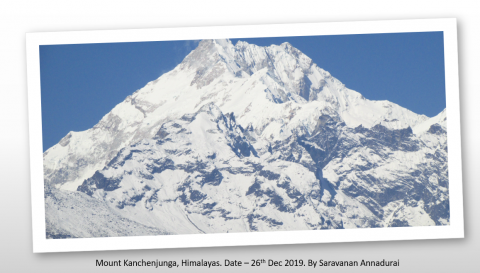We can invest a lot of time in developing a world class strategy but, if we are not effective in executing that strategy, we have simply wasted our time.
After my first trip to the Himalayas in 2013, I found a new passion for mountains and high-altitude hiking. To date, I have summited five peaks that are at an elevation of 12,000+ ft, in the Indian and Nepal side of the Himalayan ranges, with my highest peak being 15,000 ft. There is a new learning opportunity every time I go to the mountains.
Mountains are a real-world training ground and making mistakes while climbing a mountain, can have serious consequences. This makes high-altitude hiking and mountaineering an effective but unforgiving teacher. Many of the lessons learnt from the world of mountains can provide parallel lessons to the world of business.
The higher you climb on the mountain, the harder the wind blows – Sam Cummings
Look closely and you will find a strong correlation between climbing mountains and executing a business strategy successfully. Here are 5 of the most common pitfalls we should watch out for:
- Strategy
Research says ‘90% of Business Strategies Fail Due to Poor Execution’ – Reference “
The Balanced Scorecard” by author David Norton and Robert Kaplan.
Many a times, companies try to execute on things which are not even a strategy. It might be goals, missions, or something else altogether, but they are not technically a strategy. We need to understand that strategy is the answer to the question “How are we going to achieve the goals and objectives?”.
Going to the top of a mountain is a goal and how to get to the top, is a strategy. Now, getting to the top is a collection of steps. Sometimes, the first step is the hardest, with thousands more to go. Imagine that it is freezing cold outside the tent, you are enveloped by darkness, and there’s low oxygen concentration in the air, how easy do you think it would be to take that first step? Not easy.
It is better to break the bigger goal into more manageable, incremental goals, and try to make it easier to commit to the first step. In the end we only regret to the step we didn’t take.
So, if you hear statements like becoming a market leader or the best organization is our strategy, then we need to step back and say that’s not a strategy, as it only conveys what is that we are going to achieve and does not indicate how we are going to achieve it.
- Resources
Quite often, we get so excited by creating an excellent plan that we jump right into execution without giving it much consideration. We need to have that step in between, where we ask ourselves – do we have the resources (people, time, and budget) to be successful in executing those plans? If not, we really need to prioritize and let people know that we have resources for some part of the plan, but not for all.
In the mountains, ‘
Alpine’ style climbing can be compared with a ‘
Lean’ and ‘A
gile’ project. Alpine style climbers are small motivated teams who use their agility, to climb to the top and return to camp with only what is required for the climb. In contrast the ‘Expedition’ style uses camps stocked with supply and gear, with manpower support, to make their way to the top. This is what you often see now-a-days with climbers in the Himalayas. Needless to say, the expedition style is not only expensive, it is not very efficient in adapting to changing conditions either.
Failure is always a possibility in the mountains. At times, you must turn back if you don’t have the right gear, or face an obstacle that you can’t go around, or if a team member is unable to continue due to high-altitude sickness. It’s simply no longer safe to continue due to a lack of resources. In 2018, I made an unsuccessful attempt to summit the Everest Base Camp (located at 17,600 ft), near Khumbu icefall in Nepal.
- Communication
Research from the Harvard Business Review shows that in large organizations, 95% of employees don’t understand or are unaware of the company strategy. No organization can perform its best, with only 5% of its people rowing in the same direction. It’s important to have a clear line of communication with well-defined and simple ways to communicate the strategic direction to our colleagues.
Communication can be a funny thing. It’s so simple, yet we frequently make assumptions that lead to miscommunications, which in turn leads to unfavorable outcomes.
In the mountains, no matter what kind of terrain we are in, constant communication with our team members, either visually or verbally, could be the difference between life and death, in a rescue situation. Communication in such complex terrain requires careful planning and it is important to remember not to make any assumptions.

- Accountability
Lack of accountability often arises from ineffective practices and mindsets. Keep an eye out for warning signals such as low morale, unclear priorities, low levels of trust, and declining engagement, as these have huge potential to create chaos and disrupt the team’s culture and results.
There is constant exposure to danger in the mountains as well, and you are always trying to find the right balance between reaching the objective and doing it safely. Accidents can happen because of bad weather, not enough experience, faulty gear or bad judgement.
In ‘Alpine’ style climbing, there is a constant feedback mechanism which empowers the team to make informed decisions, based on learnings from the mistakes of their peers, and they are 100% accountable for their safe return from the top.
- Calibration
Most of us would not think of going a year or so in our car without changing the oil or filters, but in business we sometimes go a year or more without revisiting our strategies. It is recommended to have a strategy tune-up on a regular basis, either monthly or at least quarterly, to look at the business. See what’s changing in the market, and benchmark performances by customers and competitors. Based on those inputs, ask yourself if you need to make any changes to your strategy – the tactics or the goal itself.
In the world of mountains, a strategy calibration is required at a much higher interval, as compared to a regular project. At least on an hourly basis, if not more, and this is due to the ever-changing climatic conditions, tough terrain and other risks associated at higher altitudes. Managing and mitigating these risks constantly would ensure your safe return.
In conclusion,
-
- Leaders should communicate a well-defined and clear company strategy to all team members, in a way that’s easy for them to understand.
-
- It is always important to have the target in sight, but it is equally important to not turn a blind-eye towards the changing environment.
-
- Leaders should breakdown the bigger goals for their employees into smaller manageable goals and empower them to be 100% accountable in their work.
-
- Achieving any target or goal takes time, dedication, and preparedness to succeed. Keep training yourself and acquire learning and knowledge, to understand your strengths and weakness.
I leave you with this famous mountaineering quote:
“Standing at the foothill, I look up and the peaks whisper,
It’s always further than it looks.
It’s always taller than it looks.
And it’s always harder than it looks.
So, climb up!!!”
– Unknown Author





